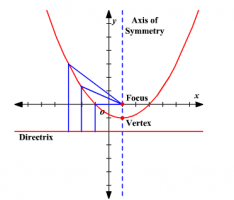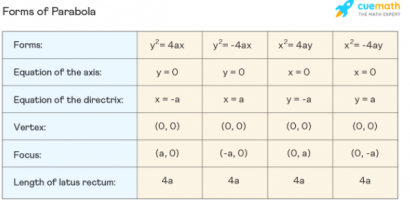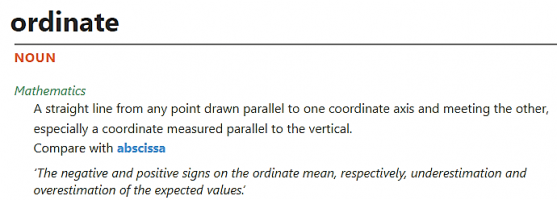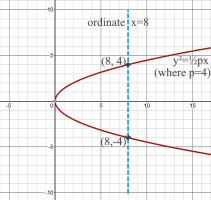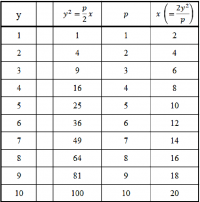You are using an out of date browser. It may not display this or other websites correctly.
You should upgrade or use an alternative browser.
You should upgrade or use an alternative browser.
parabola
- Thread starter Loki123
- Start date
BigBeachBanana
Senior Member
- Joined
- Nov 19, 2021
- Messages
- 2,182
The Highlander
Full Member
- Joined
- Feb 18, 2022
- Messages
- 949
What parabola? Is this a sub-part of a bigger question where a particular parabola is provided/defined?Determine the geometric location in the middle of the ordinate of the points of the parabola.
Can someone explain what "the middle of the ordinate of the points of the parabola" is? preferably with a picture.
The question stipulates "points" (plural). If you rotate BigBeachBanana's parabola through 90° then 2 points will lie on it and, clearly, you also need to know which ordinate is referred to!
As BigBeachBanana suggests, this has the look of having been (poorly) translated into English; is that the case?
I suspect there is more information you could have provided for us to help but it may be you now have enough to proceed?
Please come back and tell us more (whether you now have enough or not).
It is translated as best as I could. By parabola it is considered the standard formula y2=2pxWhat parabola? Is this a sub-part of a bigger question where a particular parabola is provided/defined?
The question stipulates "points" (plural). If you rotate BigBeachBanana's parabola through 90° then 2 points will lie on it and, clearly, you also need to know which ordinate is referred to!
As BigBeachBanana suggests, this has the look of having been (poorly) translated into English; is that the case?
I suspect there is more information you could have provided for us to help but it may be you now have enough to proceed?
Please come back and tell us more (whether you now have enough or not).
is focus (p/2, 0), where p is from the y2=2pxSounds like it was translated. Possibly mean the "focus of the parabola"?
View attachment 31440
BigBeachBanana
Senior Member
- Joined
- Nov 19, 2021
- Messages
- 2,182
The Highlander
Full Member
- Joined
- Feb 18, 2022
- Messages
- 949
Please provide the whole question (a picture of it would be good)..It is translated as best as I could. By parabola it is considered the standard formula y2=2px
It might be useful to provide it in the original language too along with your translation?
yesAre you missing the ^ to indicate the exponent?
View attachment 31441
There is no picture. I doubt the original language would be useful since I doubt you speak it.Please provide the whole question (a picture of it would be good)..
It might be useful to provide it in the original language too along with your translation?
Here is another translations:
Determine the geometric locus of the middle of the ordinate points of the parabola y^2=2px.
this is as accurate as it can get
D
Deleted member 4993
Guest
I am assuming you are referring to an eastern European language. There are many scholars in the universities here - some of them do speak/write various slavic/eastern European languages. Give it a try - nothing to lose.There is no picture. I doubt the original language would be useful since I doubt you speak it.
Here is another translations:
Determine the geometric locus of the middle of the ordinate points of the parabola y^2=2px.
this is as accurate as it can get
Dr.Peterson
Elite Member
- Joined
- Nov 12, 2017
- Messages
- 16,113
Determine the geometric location in the middle of the ordinate of the points of the parabola.
Perhaps if you can tell us how you define the terms you are using in your translation, we can find a way to put them together.Determine the geometric locus of the middle of the ordinate points of the parabola y^2=2px.
Using the word locus helps a lot. My trouble is "the ordinate of the points" or "the ordinate points". As I understand it, an ordinate is the y-coordinate of a point. Does it mean something different to you, so that "ordinate point" would make sense? It can't be talking about all the points of the parabola, but perhaps something like your other question about the locus of midpoints of chords of a parabola?
But I agree with others that if you show us the entire problem, it may give us some ideas we are missing (especially if there is a picture, or if there are multiple parts to the problem); and if you can provide the original words in a form we can try in Google Translate or other tools, we might be able to get more perspectives on it. I'd love to try.
Otherwise, you probably need to ask a mathematician in your country.
First translation is google translate, second is my own. There are no pictures and I am as confused about the wording of the problem as you are. It makes no sense to me.Perhaps if you can tell us how you define the terms you are using in your translation, we can find a way to put them together.
Using the word locus helps a lot. My trouble is "the ordinate of the points" or "the ordinate points". As I understand it, an ordinate is the y-coordinate of a point. Does it mean something different to you, so that "ordinate point" would make sense? It can't be talking about all the points of the parabola, but perhaps something like your other question about the locus of midpoints of chords of a parabola?
But I agree with others that if you show us the entire problem, it may give us some ideas we are missing (especially if there is a picture, or if there are multiple parts to the problem); and if you can provide the original words in a form we can try in Google Translate or other tools, we might be able to get more perspectives on it. I'd love to try.
Otherwise, you probably need to ask a mathematician in your country.
Here is the answer to the question, maybe you can from that understand what the question is about...
y^2=(p/2)x
Unlike the other problems, the solution for this answer is written with capital letters..
Y^2=(p/2)X
I do not see a reason for this, but maybe there is one, apart from it being a mistake.
I tried to graphing for p=1First translation is google translate, second is my own. There are no pictures and I am as confused about the wording of the problem as you are. It makes no sense to me.
Here is the answer to the question, maybe you can from that understand what the question is about...
y^2=(p/2)x
Unlike the other problems, the solution for this answer is written with capital letters..
Y^2=(p/2)X
I do not see a reason for this, but maybe there is one, apart from it being a mistake.
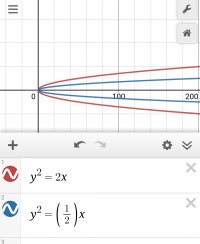
So solution is the blue parable, what is that in relation to the red parable?
Dr.Peterson
Elite Member
- Joined
- Nov 12, 2017
- Messages
- 16,113
Why didn't you tell us from the start that you were given a solution? That is really another part of "the whole problem" that we ask for, as it can help clarify confusing problems. It should help a lot here, in principle.Here is the answer to the question, maybe you can from that understand what the question is about...
y^2=(p/2)x
But also, you said this earlier:
To me, the standard formula is y^2 = 4px, where p is the focal length. Are you sure of the 2?By parabola it is considered the standard formula y2=2px
And perhaps I should have made this clearer: It is a little offensive to tell us we can't possibly gain anything from seeing the original language, when we have explicitly asked to see it. Why do you think you know everyone on this site that well? Just give us what we ask, and let us try (e.g. finding a dictionary and looking up the breadth of meaning of a key word). Some of us like challenges, and some may have an uncle or a colleague who knows the language.
Unfortunately, though, I have no new insights from seeing the answer. Perhaps we should all just give up and consider it a worthless problem?
The Highlander
Full Member
- Joined
- Feb 18, 2022
- Messages
- 949
My understanding would have been similar to yours, Dr.P, eg: a point in the coordinate plane would be written as (abscissa, ordinate). However, the Oxford English Dictionary gives the definition shown in the attached picture (or see the source website here).Perhaps if you can tell us how you define the terms you are using in your translation, we can find a way to put them together.
Using the word locus helps a lot. My trouble is "the ordinate of the points" or "the ordinate points". As I understand it, an ordinate is the y-coordinate of a point. Does it mean something different to you, so that "ordinate point" would make sense? It can't be talking about all the points of the parabola, but perhaps something like your other question about the locus of midpoints of chords of a parabola?
But I agree with others that if you show us the entire problem, it may give us some ideas we are missing (especially if there is a picture, or if there are multiple parts to the problem); and if you can provide the original words in a form we can try in Google Translate or other tools, we might be able to get more perspectives on it. I'd love to try.
Otherwise, you probably need to ask a mathematician in your country.
But a vertical straight line certainly doesn't fit with the given answer (y²=½px)!
Kinda takes me back to my original post #3 qv (about rotating BigBeachBanana's first parabola) then an ordinate (x=8) will have two points on the parabola lying on it: (8, 4) & (8,-4); see attached diagram.
Attachments
The Highlander
Full Member
- Joined
- Feb 18, 2022
- Messages
- 949
Hmmm, having constructed my diagram (above @ Post #15) and given some further thought to the matter, in light of that, I think I can now see how the answer given (y²=½px), actually does work; though I have absolutely no idea of how to arrive at it with just the information provided in the original question (as first posted).My understanding would have been similar to yours, Dr.P, eg: a point in the coordinate plane would be written as (abscissa, ordinate). However, the Oxford English Dictionary gives the definition shown in the attached picture (or see the source website here).
But a vertical straight line certainly doesn't fit with the given answer (y²=½px)!
Kinda takes me back to my original post #3 qv (about rotating BigBeachBanana's first parabola) then an ordinate (x=8) will have two points on the parabola lying on it: (8, 4) & (8,-4); see attached diagram.
I constructed the table below (qv) which, may not exactly prove the result but certainly appears to verify it. Please see the attached table in which I have considered the range of y-values that produce the perfect squares only.
It would seem, therefore, that for any given parabola of the form y²=½px the points (x, p) & (x,-p) will, indeed, lie on the ordinate (vertical line) x=2p so p does give the magnitude of the y-values (ordinates?) sought.
Does that make any sense???
(I still suspect that something has been "lost in translation" however: "in the middle(?) of the ordinate" still bamboozles me!)
Attachments
Last edited:
F(p/2,0)Why didn't you tell us from the start that you were given a solution? That is really another part of "the whole problem" that we ask for, as it can help clarify confusing problems. It should help a lot here, in principle.
But also, you said this earlier:
To me, the standard formula is y^2 = 4px, where p is the focal length. Are you sure of the 2?
And perhaps I should have made this clearer: It is a little offensive to tell us we can't possibly gain anything from seeing the original language, when we have explicitly asked to see it. Why do you think you know everyone on this site that well? Just give us what we ask, and let us try (e.g. finding a dictionary and looking up the breadth of meaning of a key word). Some of us like challenges, and some may have an uncle or a colleague who knows the language.
Unfortunately, though, I have no new insights from seeing the answer. Perhaps we should all just give up and consider it a worthless problem?
y^2=2px
Perhaps for you it's F(p, 0).so that's why you have 4 instead of 2
The only part I can clarify that I translated good is "the middle of", it's used in all previous questions and that translation always worked.Hmmm, having constructed my diagram (above @ Post #15) and given some further thought to the matter, in light of that, I think I can now see how the answer given (y²=½px), actually does work; though I have absolutely no idea of how to arrive at it with just the information provided in the original question (as first posted).
I constructed the table below (qv) which, may not exactly prove the result but certainly appears to verify it. Please see the attached table in which I have considered the range of y-values that produce the perfect squares only.
It would seem, therefore, that for any given parabola of the form y²=½px the points (x, p) & (x,-p) will, indeed, lie on the ordinate (vertical line) x=2p so p does give the magnitude of the y-values (ordinates?) sought.
Does that make any sense???
(I still suspect that something has been "lost in translation" however: "in the middle(?) of the ordinate" still bamboozles me!)
Dr.Peterson
Elite Member
- Joined
- Nov 12, 2017
- Messages
- 16,113
Changing "ordinate points" to "ordinates of points" as I have done here, and taking the ordinate of a point as the vertical segment from the axis to the point, this amounts toDetermine the geometric locus of the middle of the ordinate [of] points of the parabola y^2=2px.
Find the locus of the midpoint of the segment from (x,0) to (x,y) for any (x,y) on the parabola.
or
Divide y by 2 for every point on the parabola.
So y^2 will be 1/4 of what it was for the given parabola, namely y^2 = 1/4 * 2px = 1/2 px. That explains the answer. It also makes it a rather trivial problem, once understood.
If we had asked you to define "ordinate", would you have been able to tell us that in your language it refers to this segment, rather than to the coordinate itself? That might have saved us some time.
No, I wouldn't have. I didn't understand the question since we knew use the term ordinate in that way, you can see that in my the first post I expressed concern over the meaning of it.
However I seem to be having problems solving this. The points we are looking for have coordinates (x,y/2), put that in the y^2=2px and you get
y^2/4=2px
y^2=8px
obviously not correct
However I seem to be having problems solving this. The points we are looking for have coordinates (x,y/2), put that in the y^2=2px and you get
y^2/4=2px
y^2=8px
obviously not correct

